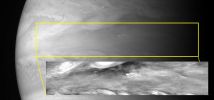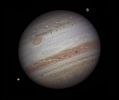Jupiter: the "King" and His Moons
|
|
|

Jupiter-PIA02401.jpgLook at Me!58 visiteWhen 17th-century astronomers first turned their telescopes to Jupiter, they noted a conspicuous reddish spot on the Giant Planet. This Great Red Spot is still present in Jupiter's atmosphere, more than 300 years later. It is now known that it is a vast storm, spinning like a cyclone. Unlike a low-pressure hurricane in the Caribbean Sea, however, the Red Spot rotates in a counterclockwise direction in the Southern Hemisphere, showing that it is a high-pressure system. Winds inside this Jovian storm reach speeds of about 270 mph.
The Red Spot is the largest known storm in the Solar System. With a diameter of about 15.400 miles, it is almost twice the size of the entire Earth and 1/6th the diameter of Jupiter itself.
The long lifetime of the Red Spot may be due to the fact that Jupiter is mainly a gaseous planet. It possibly has liquid layers, but lacks a solid surface, which would dissipate the storm's energy, much as happens when a hurricane makes landfall on the Earth. However, the Red Spot does change its shape, size, and color, sometimes dramatically. Such changes are demonstrated in high-resolution Wide Field and Planetary Cameras 1 & 2 images of Jupiter obtained by NASA's Hubble Space Telescope between 1992 and 1999(PIA01594 thru PIA01599 and PIA02400 thru PIA02402). This image was obtained in April 1997.
|
|

Jupiter-PIA02865-1.JPGJupiter's clouds - 619 nnmts filter53 visiteThe images shown here demonstrate the power of these filters in studies of cloud stratigraphy. The images cover latitudes from about 15° North at the top down to the Southern Polar Region at the bottom. (...)
The most prominent feature seen in all 3 filters is the Polar Stratospheric Haze that makes Jupiter bright near the Pole. The equatorial band is also very bright in the strong 890-nnmts image and to a lesser extent in the 727 band, but is subdued in the weak 619-nnmts image. These are high, thin, haze layers that are nearly transparent at wavelengths outside the methane absorption bands.
Another prominent feature is the Great Red Spot: about a third of it appears at the right-hand edge of the frame.
It is a bright feature in methane absorption because it has extensive cloud cover reaching to high altitude.
A wisp of high thin cloud can be seen trailing off its western rim in the 2nd and 3rd image.
|
|

Jupiter-PIA02865-2.JPGJupiter's clouds - 727 nnmts filter54 visiteAll the already mentined Jovian features have also been seen from ground-based telescopes, from NASA's HST and from NASA's Galileo spacecraft.
Chief among these features is the very dark patch seen in the weak methane image (619 nnmts) near the top-middle of the frame.
It is almost invisible in the next image (890 nnmts) and it appears to be composed of strands of bright clouds in this frame (727 nnmts).
This is a Region similar to the "hot spot" where the Galileo Probe entered Jupiter's atmosphere in 1995.
These images indicate that cloud cover is present at the higher altitudes but absent from the lower altitudes and this is also what the Galileo Probe found when it entered Jupiter's atmosphere.
|
|

Jupiter-PIA02865-3.JPGJupiter's clouds - 890 nnmts filter55 visiteTo the North-West (above and to the left) of the dark feature is a small cloud that is bright in the 619-nnmts image but has no contrast at the other wavelengths. This is the signature expected for a thick water cloud. Another feature seen only in the weak-methane ratio is a dark ring near the center of the image.
This feature is probably a counter-clockwise rotating, upwelling core surrounded by a sinking perimeter with diminished cloudiness. The fact that it is seen only in the weak methane ratio indicates the effects of a lower-level circulation that does not penetrated to the upper ammonia cloud level and may be confined to the deeper water cloud.
The opposite behavior is evident in an oval storm that appears dark in 727 and 890 nnmts images, but is absent in the weak 619-nnmts frame. It is located to the South-West of the Great Red Spot. Further to the West - at slightly more Northerly Latitudes - are a series of small spots that are dark at all wavelengths.
These and a myriad of other contrast features at many latitudes reveal much about Jupiter's complicated cloud structure and meteorology.
|
|

Jupiter-PIA02865-4.jpgA "deep look" in the "deep clouds" of Jupiter53 visiteFinally, this is the combination of the 3 images taken from Cassini using the 3 different filters.
This picture reveals cloud structures and movements at different depths in the atmosphere around Jupiter's South Pole. Cassini's cameras come equipped with filters that sample 3 wavelengths where Methane gas absorbs light. These are in the RED (619 nnmts) and in the NEAR-INFRARED (at 727 and 890 nnmts). Absorption in the 619 nnmts filter is weak. It is stronger in the 727 nnmts band and very strong in the 890 nnmts band where 90% of the light is absorbed by Methane gas.
Light in the weakest band can penetrate the deepest into Jupiter's atmosphere. It is sensitive to the amount of cloud and haze down to the pressure of the water cloud (which lies at a depth where pressure is about 6 times the atmospheric pressure at sea level on the Earth).
Light in the strongest methane band is absorbed at high altitude and is sensitive only to Ammonia cloud level and higher (with pressures less than about one-half of Earth's atmospheric pressure) and the middle methane band is sensitive to the ammonia and ammonium hydrosulfide cloud layers as deep as two times Earth's atmospheric pressure.
|
|

Jupiter-PIA02873.jpgJupiter, from Cassini53 visiteOriginal caption:"This true-color simulated view of Jupiter is composed of 4 images taken by NASA's Cassini spacecraft on December 7, 2000. To illustrate what Jupiter would have looked like if the cameras had a field-of-view large enough to capture the entire Planet, the cylindrical map was projected onto a globe. The resolution is about 144 Km (about 89 miles) per pixel. Jupiter's moon Europa is casting the shadow on the Giant Gas Planet".
|
|

Jupiter-PIA02880.jpgThe "Heat" of Jupiter53 visiteOriginal caption:"These images taken through the wide angle camera near closest approach in the deep near-infrared methane band, combined with filters which sense electromagnetic radiation of orthogonal polarization, show that the light from the Poles of Jupiter is "polarized".
That is, the Poles appear bright in one image, and dark in the other. Polarized light is most readily scattered by aerosols. These images indicate that the aerosol particles at Jupiter's Poles are small and likely consist of aggregates of even smaller particles, whereas the particles at the Equator and covering the Great Red Spot are larger.
Images like these will allow scientists to ascertain the distribution, size and shape of aerosols, and consequently, the distribution of heat, in Jupiter's atmosphere".
|
|

Jupiter-PIA10076.jpgAmmonia Ice-Clouds on Jupiter54 visiteCaption NASA:"The top cloud layer on Jupiter is thought to consist of ammonia ice, but most of that ammonia "hides" from spectrometers. It does not absorb light in the same way ammonia does. To many scientists, this implies that ammonia churned up from lower layers of the atmosphere "ages" in some way after it condenses, possibly by being covered with a photochemically generated hydrocarbon mixture.
The New Horizons Linear Etalon Imaging Spectral Array (LEISA), the half of the Ralph instrument that is able to see in infrared wavelengths that are absorbed by ammonia ice, spotted these clouds and watched them evolve over 5 Jupiter days (about 40 Earth hours). In these images, spectroscopically identified fresh ammonia clouds are shown in bright blue. The largest cloud appeared as a localized source on day 1, intensified and broadened on day 2, became more diffuse on days 3 and 4, and disappeared on day 5.
The diffusion seemed to follow the movement of a dark spot along the boundary of the oval region. Because the source of this ammonia lies deeper than the cloud, images like these can tell scientists much about the dynamics and heat conduction in Jupiter's lower atmosphere".MareKromium
|
|

Jupiter-PIA10096.jpgPolar Lightning on Jupiter54 visiteCaption NASA:"Images taken by the New Horizons Long-Range Reconnaissance Imager (LORRI) of Jupiter's night side showed lightning strikes.
Each "strike" is probably the cumulative brightness of multiple strikes. This is the first lightning seen at High Latitudes on Jupiter; it demonstrates that convection is not confined to lower latitudes, implying an internal driving heat source.
Their power is consistent with previous lightning measurements at Jupiter's Lower Latitudes, equivalent to extremely bright terrestrial "super bolts".MareKromium
|
|

Jupiter-PIA10097.jpgAtmospheric Waves54 visiteWith its Multispectral Visible Imaging Camera (MVIC), half of the Ralph instrument, New Horizons captured several pictures of mesoscale gravity waves in Jupiter's Equatorial Atmosphere. Buoyancy waves of this type are seen frequently on Earth - for example, they can be caused when air flows over a mountain and a regular cloud pattern forms downstream. In Jupiter's case there are no mountains, but if conditions in the atmosphere are just right, it is possible to form long trains of these small waves.
The source of the wave excitation seems to lie deep in Jupiter's atmosphere, below the visible cloud layers at depths corresponding to pressures 10 times that at Earth's surface. The New Horizons measurements showed that the waves move about 100 mt-per-second faster than surrounding clouds; this is about 25% of the speed of sound on Earth and is much greater than current models of these waves predict.
Scientists can "read" the speed and patterns these waves to learn more about activity and stability in the atmospheric layers below".MareKromium
|
|

Jupiter-PIA12869.jpgHow "Hot " is Jupiter?54 visiteCaption NASA:"New thermal images from powerful ground-based telescopes show swirls of warmer air and cooler regions never seen before within Jupiter's Great Red Spot. The images enable scientists to make the first detailed weather map of the inside of the giant storm system. One observation illustrated by this image is the correspondence between a warm core within an otherwise cold storm system and the reddest color of the Great Red Spot.
The image on the top was obtained by the European Southern Observatory's Very Large Telescope in Chile on May 18, 2008. It was taken in the InfraRed wavelength range of 10.8 microns, which is sensitive to Jupiter's Atmospheric Temperatures in the 300 to 600 millibar pressure range. That pressure range is close to the altitude of the white, red and brown aerosols seen in the visible-light image on the bottom, which was obtained by the Hubble Space Telescope on May 15, 2008.
These images show the interaction of three of Jupiter's largest storms -- the Great Red Spot and two smaller storms nicknamed Oval BA and Little Red Spot".MareKromium
|
|

Jupiter-PIA14410.jpgJupiter and "Sons": Io and Ganymede85 visitenessun commentoMareKromium
|
|
| 318 immagini su 27 pagina(e) |
 |
 |
 |
 |
 |
22 |  |
 |
 |
 |
|

